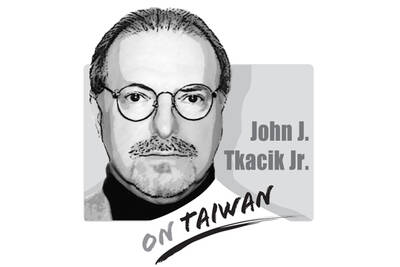A full, independent investigation into the killings of Palestinians attempting to collect food for their family, and accountability for their deaths, is essential, but no investigation is needed to establish that Israel is ultimately responsible, by starving people and then implementing a food-collection scheme that cannot solve the humanitarian crisis, and which is known to be dangerous. The US, which promoted that scheme, is complicit.
Health officials in Gaza said that at least 27 people were killed by Israeli fire as they awaited food on Tuesday last week — the third such incident in three days.
The Israeli military said troops fired at people “moving towards [them] ... in a way that posed a threat.”
Officials previously said that Israeli forces killed more than 30 Palestinians on June 1, and another three the following day; the Israeli military said it did not shoot civilians, but fired “warning shots.”
The Gaza Humanitarian Foundation (GHF) — the US private organization running the scheme — suspended operations on Wednesday for “update, organization and efficiency improvement work.”
No update can fix this: The food scheme itself is the problem. The UN and aid agencies feared that it breached international law and refused to work with the GHF; the founding director resigned, saying that GHF would not be able to deliver aid while adhering to humanitarian principles. Senior Israeli military officials reportedly raised concerns. Many people cannot reach the sites. Those who do face a greater risk of having meagre supplies snatched by other desperate people. Essential non-food goods such as medications are not included. The risk of shootings was clear: armed US contractors run the three sites and Israeli troops control the surrounding areas. Palestinians are forced to choose — risk their lives or watch their children starve.
After 11 weeks of total siege, followed by a trickle of supplies, Gaza is the hungriest place on Earth, the UN said.
It was never plausible that this scheme could feed it. It is a fig leaf for Israel’s continued starvation of civilians, and helps displace them to an ever smaller area. The far-right Israeli Minister of Finance Bezalel Smotrich has said that Gaza would be “entirely destroyed” so that its population would “leave in great numbers to third countries.” In short, ethnic cleansing.
The use of food as a weapon comes in addition to strikes on schools being used as shelters, the destruction of hospitals and the killing of tens of thousands of civilians. Israel’s war crimes have caused public support to plummet in western Europe and fall markedly in the US. Yet politicians are lagging. British Prime Minister Keir Starmer calls the situation “intolerable,” but until the UK acts decisively it is, in reality, tolerating it. The UK, France and Canada warned of “concrete measures” and must follow through. The US could stop this conflict tomorrow, but the EU, Israel’s biggest trading partner, also has real power. It is now reviewing its trade agreement with Israel; it should suspend it. Improving aid is a necessary, but not sufficient demand. The need is created by the war. The real solution is still a ceasefire and release of the hostages seized by Hamas on Oct. 7, 2023.
As International Committee of the Red Cross president Mirjana Spoljaric has warned, international law itself is being hollowed out — with profound implications for conflicts to come. As long as Israel enjoys impunity, more Palestinians die and human lives everywhere are cheapened. It must be held accountable.

Elbridge Colby, America’s Under Secretary of Defense for Policy, is the most influential voice on defense strategy in the Second Trump Administration. For insight into his thinking, one could do no better than read his thoughts on the defense of Taiwan which he gathered in a book he wrote in 2021. The Strategy of Denial, is his contemplation of China’s rising hegemony in Asia and on how to deter China from invading Taiwan. Allowing China to absorb Taiwan, he wrote, would open the entire Indo-Pacific region to Chinese preeminence and result in a power transition that would place America’s prosperity
When Democratic Progressive Party (DPP) caucus whip Ker Chien-ming (柯建銘) first suggested a mass recall of Chinese Nationalist Party (KMT) legislators, the Taipei Times called the idea “not only absurd, but also deeply undemocratic” (“Lai’s speech and legislative chaos,” Jan. 6, page 8). In a subsequent editorial (“Recall chaos plays into KMT hands,” Jan. 9, page 8), the paper wrote that his suggestion was not a solution, and that if it failed, it would exacerbate the enmity between the parties and lead to a cascade of revenge recalls. The danger came from having the DPP orchestrate a mass recall. As it transpired,
A few weeks ago in Kaohsiung, tech mogul turned political pundit Robert Tsao (曹興誠) joined Western Washington University professor Chen Shih-fen (陳時奮) for a public forum in support of Taiwan’s recall campaign. Kaohsiung, already the most Taiwanese independence-minded city in Taiwan, was not in need of a recall. So Chen took a different approach: He made the case that unification with China would be too expensive to work. The argument was unusual. Most of the time, we hear that Taiwan should remain free out of respect for democracy and self-determination, but cost? That is not part of the usual script, and
All 24 Chinese Nationalist Party (KMT) lawmakers and suspended Hsinchu Mayor Ann Kao (高虹安), formerly of the Taiwan People’s Party (TPP), survived recall elections against them on Saturday, in a massive loss to the unprecedented mass recall movement, as well as to the ruling Democratic Progressive Party (DPP) that backed it. The outcome has surprised many, as most analysts expected that at least a few legislators would be ousted. Over the past few months, dedicated and passionate civic groups gathered more than 1 million signatures to recall KMT lawmakers, an extraordinary achievement that many believed would be enough to remove at